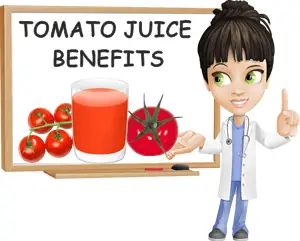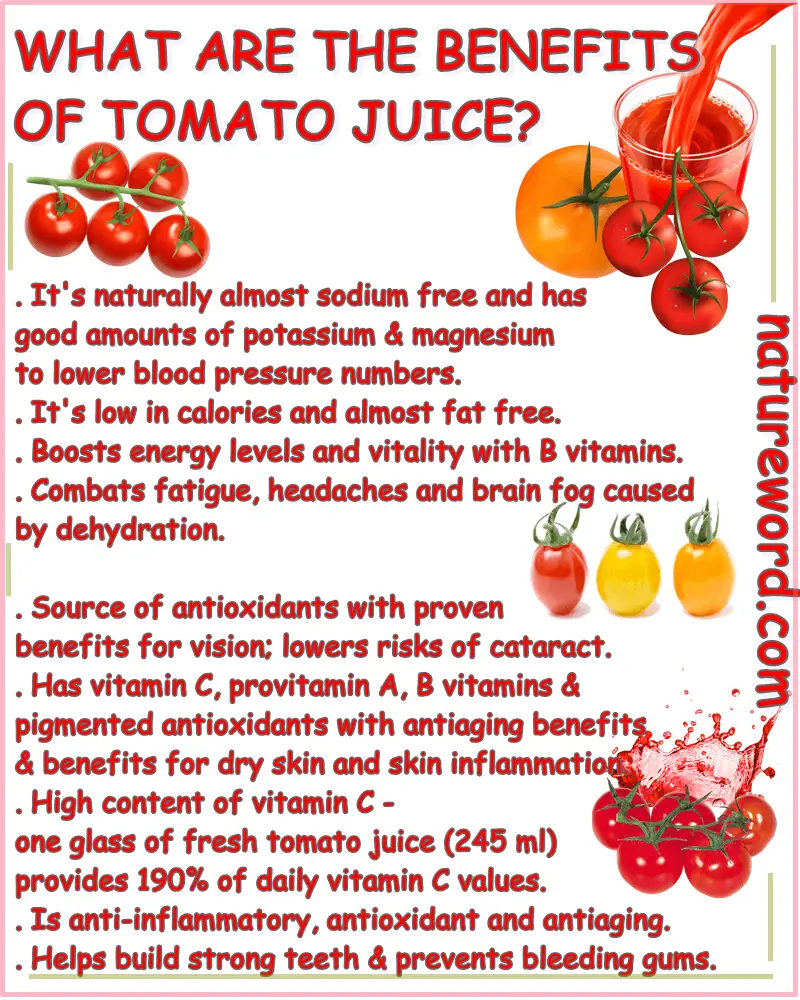Tomato juice is a healthy juice to drink during the summer and it dubs as a fruit and vegetable juice. It can be made fresh from raw tomatoes such as red, orange, black or yellow tomatoes and consumed plentifully when it’s hot outside. If you don’t have acid reflux, then tomato juice can be a source of many benefits for health. From better blood pressure numbers to increased vitality and benefits for skin and eyes, tomato juice is the juice to try this summer.
What are the benefits of tomato juice?
1- It’s a seasonal juice and can be made from tomatoes grown locally
Eating local and eating in season are the two of the founding principles of a clean diet. And right now, tomatoes are both in full season, and available as a local food due to their extensive cultivation. And tomato juice too. Red and yellow tomatoes are great options for tomato juice as they’re available plentifully, and accessible price wise, but you can also try tomato juice made from black tomatoes or orange tomatoes or even blue tomatoes.

2- Good for high blood pressure
Tomato juice is good for high blood pressure for several reasons. One, it’s full of water and naturally very low in sodium which helps maintain healthy blood volume levels and doesn’t cause blood pressure to rise in the first place. Foods and beverages that are low sodium are good this time of the year because they reduce risks of cardiovascular events brought on by high temperatures.
Two, tomato juice is a good source of dietary potassium and magnesium, two electrolytes with direct benefits for blood pressure. Potassium and magnesium relieve pressure in blood vessels which contributes to lowering blood pressure numbers. Not just this, but potassium and magnesium both help counteract the side effects of sodium in the diet.
Thirdly, red tomatoes contain a pigmented antioxidant carotene called lycopene. Lycopene is what makes red tomatoes red. Studies have shown lycopene has an antihypertensive action and is effective at lowering blood pressure numbers by a few points, systolic blood pressure in particular.

3- Low in calories and virtually free of fat
Pure tomato juice is naturally very low in calories and almost fat-free. How many calories in tomato juice? There are only 42 kilocalories (calories) in one glass of pure tomato juice at 245 milliliters. How much fat in tomato juice? There are only 0.7 milligrams of fat in one glass of pure tomato juice. Because it’s so low in fat and calories, tomato juice is good for cardiovascular health and helps with weight loss.
4- Hydrating action, combats fatigue, brain fog and headaches
It goes without saying that tomato juice is an excellent option to keep yourself hydrated in summer and even during a heatwave. High in water with a 94% water content, tomato juice combats lethargy, fatigue, headaches and brain fog associated with dehydration and provides an almost instant feeling of well being all the while boosting motivation and productivity.
5- Boosts energy levels
Drinking tomato juice can help boost energy levels. The juice is an especially good source of B vitamins that hold benefits for energy metabolism. Just one glass of tomato juice at 245 milliliters provides over 20% of the total daily values of vitamin B1 for an adult. A glass of tomato juice provides 6.8% of daily vitamin B2 values, 9.7% of vitamin B3 values, 10% of vitamin B6 values and over 12% of vitamin B9 values.
6- Increases vitality
Just one glass of tomato juice provides 10% of all the vitamin B6 you need to get in a day and over 12% of vitamin B9. Vitamin B9 is actively involved in red blood cell production while vitamin B6 helps produce hemoglobin and boosts the capacity of hemoglobin to absorb oxygen, contributing to a boost in energy and vitality.
The functions of the two B vitamins are driving force behind the revitalizing effect of tomato juice. Not just this, but the juice helps combat anemia and associated symptoms such as fatigue and muscle weakness.
7- Benefits for eyesight
Tomato juice, particularly tomato juice made from yellow tomatoes, is a source of wonderful benefits for eyesight. The yellow pigmented xanthophyll antioxidants in the juice lutein and zeaxanthin get absorbed at the level of the retina where they exert photoprotective effects, protecting against damage from light.
According to studies, if you get enough lutein and zeaxanthin in your diet, you can reduce your risks of cataract and age related macular degeneration causing loss of vision. Risks of cataract for those with a high intake of the two yellow antioxidants are up to 32% lower, research shows (source). The same class of xanthophyll pigments is also what makes yellow raspberries yellow.
8- Good for skin
What makes tomato juice good for skin is its generous content of vitamin C, B vitamins, orange provitamin A antioxidants and other pigmented antioxidants without vitamin A activity. All the different types of pigmented antioxidants in the different tomato colors have scientifically proven antiaging effects. B vitamins in the juice are good for skin inflammation and dry skin.
Not just this, but the high content of vitamin C in the fresh juice boosts the production of collagen in the skin for better skin elasticity and a more youthful appearance. Vitamin C in tomato juice further protects against damage to skin cells, while pro-vitamin A antioxidants help with skin cell renewal.
9- High content of vitamin C
Unprocessed tomato juice is rich in vitamin C with scientifically proven anti-inflammatory and antioxidant properties. Vitamin C from tomato juice counteracts cell damage caused by harmful free radical molecules and is actively involved in lowering levels of inflammation in the body. It also boosts absorption of iron from the diet and also supplements for increased vitality.
How much vitamin C in tomato juice?
On average, one glass of fresh tomato juice at 245 milliliters has 172 milligrams of vitamin C. This is over 190% of all the vitamin C an adult needs to get in a day. However, exact amounts of vitamin C may differ between the different types of juice according to the nutritional value of the tomatoes used to make the juice, processing methods employed and other factors.
10- Exerts anti-inflammatory and antioxidant effects
Tomato juice is a wonderful source of anti-inflammatory and antioxidant benefits. Vitamin C together with pigmented red, yellow, orange, purple, blue and black pigments in the different tomato colors exert important anti-inflammatory effects and scavenge harmful free radical molecules, helping counteract, reduce and repair damage to cells.
Tomato juice is even good to drink with arthritis and gout thanks to its high content of anti-inflammatory agents, and also low content of purines.
11- Source of antiaging benefits
The antiaging benefits of tomato juice are owed primarily to its high content of vitamin C. Vitamin C stimulates the production of collagen in the skin for improved skin elasticity and a lifting effect that counteracts early wrinkles and fine lines and contributes to a more youthful appearance.
Not just this, but studies show pigmented antioxidants in tomato juice, especially red, black, blue and purple anthocyanins in purple, blue and black tomatoes exert important antiaging effects on biological systems. Research shows anthocyanin antioxidants can attenuate skin photoaging causing dryness, thickening, wrinkles and histological changes such as damage to collagen fibers (source).
12- Lower in carbs compared to other fruit juices
Tomatoes are relatively low in carbs with just 3.9 grams per 100 grams. Tomato juice has an average of 8 to 9 grams of carbs per glass (245 milliliters). This is a relatively low carb content, a lot lower than many other fruit juices.
If you are watching you carbohydrate intake, or need to lower it to better control your blood sugar, you can consider having tomato juice instead of other fruit juices.
13- Antibleeding effects
Tomato juice is a significant source of vitamin K with close to 18% of total daily values of the vitamin per 245 milliliters glass. Vitamin K supports blood coagulation and is known for its antibleeding effects, helping counteract nosebleeds and easy bruising when consumed in sufficient amounts. Vitamin C in the juice also helps strengthen blood vessel walls which further contributes to antibleeding benefits.
14- Helps build strong teeth and prevent bleeding gums
Did you know that tomato juice is good for teeth? The high content of vitamin C in the juice stimulates the production of special types of collagen called collagen types 1 and 3 which contribute to bone and teeth structure and resilience.
Not just this, but vitamin C in tomato juice strengthens the walls of capillaries, tiny blood vessels that nourish and oxygenate gums, preventing bleeding from gums as well as helps gums better adhere to teeth. Vitamin C also has anti-inflammatory and antibacterial activities which further help combat gum disease and prevent teeth loss.
The juice provides moderate amounts of minerals such as calcium, magnesium and phosphorus which physically help build bones and teeth for added strength and rigidity.
15- Has anticancer properties
One of the biggest benefits of tomato juice is its anticancer properties. Juice made from all tomato colors is a source of anticancer benefits. Antioxidants ranging from carotenoids to anthocyanins in different tomato colors have scientifically proven anticancer activities.
The anticancer effects of tomato juice include antioxidant, anti-inflammatory, antimutagenic, anti-proliferative, apoptosis and autophagy-inducing and anti-metastatic effects, among other anticancer activities.
Find out more about tomatoes as an anticancer food.
